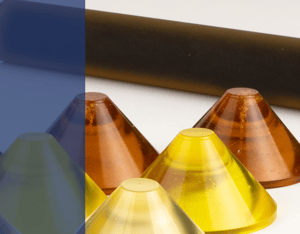Conductive Carbon Black in Plastics
Carbon black is one of the traditional additives used to create conductive materials. Since most polymers, such as rubbers, silicones, and polyurethanes, are natural insulators, incorporating conductive carbon black in the material's matrix can strengthen resistivity levels and performance. In this post, we will take a closer look at carbon black, its advantages and disadvantages, and other conductive additives that are employed in polymers like Durethane® C.
What is Conductive Carbon Black?
Carbon black is the result of incomplete combustion of heavy petroleum products, particularly oil-based fuels. Chemically speaking, it features a lattice of crystal-like carbon molecules that make this material electrically conductive. As a result, carbon black is commonly used as a conductive additive for materials such as plastics, paints, and adhesives. The resistivity levels usually range between 10-1 to 1012 ohm-cm, depending on the chemistry employed and the physical properties the material will possess. In the case of polyurethanes, using carbon black normally results in semi-conductive materials.
When to Use Conductive Carbon Black
Conductive carbon black is sometimes used in plastics to modify their mechanical and electrical properties. As briefly mentioned above, most polymers are naturally insulating materials that do not conduct electricity. In some applications, incorporating carbon black in the material's matrix can achieve the desired performance, such as conductivity, Electromagnetic Shielding (EMI), and Electrostatic Discharge (ESD). Therefore, carbon black may be found in mechanical applications such as paper and media handling, robotics, and medical devices where dissipating static build-up or transferring an electrical charge may be required. This combination can significantly reduce mechanical failures and avoid severe harm to the product or user.
While carbon black accomplishes the goal of making materials electrically conductive, it can also create some unwanted problems, including uniformity of conductivity, leaving unwanted marks, and emitting carbon molecules or debris into the environment. As an example, paper-moving applications often employ the use of carbon black in their products to dissipate static build-up. However, when the carbon-filled product comes in contact with the paper, it may leave marks, much like writing on paper with a pencil. Typically, this is problematic in media handling applications, where markings can cause unwanted results.
 Carbon Black Compared to Other Conductive Additives
Carbon Black Compared to Other Conductive Additives
There are many ways to make polymers conductive. At MPC, we developed a patented metal salts technology to create Durethane® C, which eliminates the problems created by the use of carbon black. We do this by dissolving the conductive additives in the liquid polymer, prior to curing the material. This process ensures the conductive elements are homogeneously dissipated throughout the polyurethane mixture. To learn more about polyurethane conductivity, download our conductive overview, here, or click the banner below.
When making material decisions in product design, it is important to consider the level of resistivity, physical properties, and aesthetics for a successful product design. If you are seeking manufacturing assistance for your conductive product design, feel free to contact us here with your design requirements.





